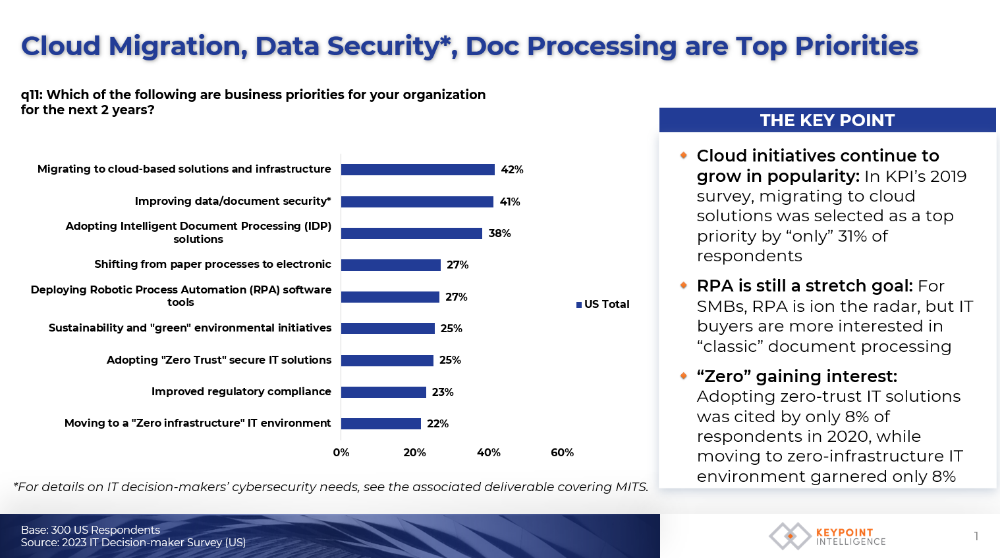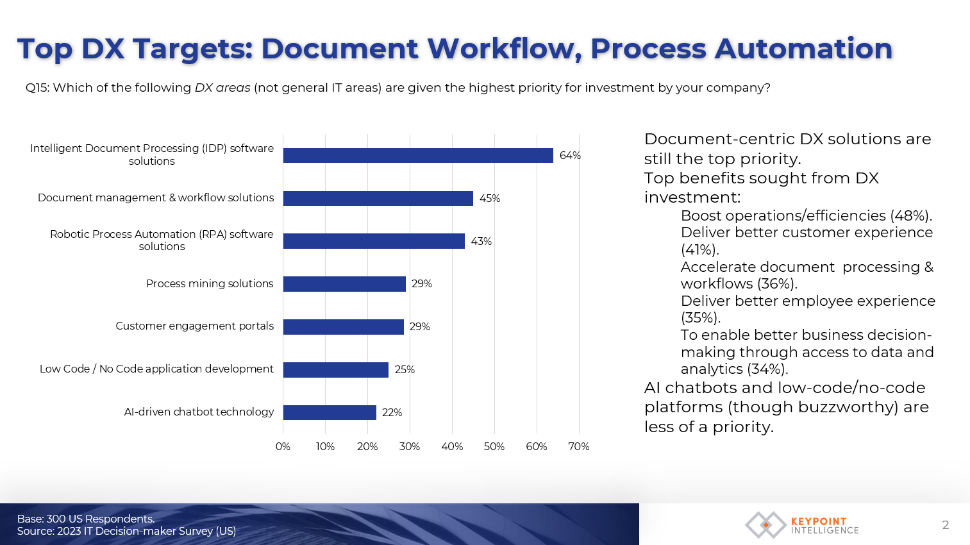AI’s Impact on Print Moving Forward
The landscape of business operations has seen numerous changes, especially in the past few years. While most of this focus has revolved around the rise of hybrid work and the digital transformation initiatives businesses are taking on, print has been quietly evolving—as it is often overlooked in discussions about innovation. In many organizations, printing has long been treated as a background task: necessary, but not central to overall business strategy. However, as businesses prioritize reshaping how they improve and update their processes to modernize their workspaces, the role of print is being reconsidered. Smart decision-makers are recognizing that even small improvements in print management can lead to significant gains across various areas, making innovation in this field more critical than ever.

With the advent of artificial intelligence (AI), these processes are undergoing a transformation that is restructuring how businesses operate. Though subtle right now, AI is a driving force behind the modernization of print processes. As AI technologies become more integrated into everyday business practices, they are becoming indispensable tools in optimizing workflows. AI not only automates routine tasks, but also provides valuable data insights that help businesses make more informed decisions about their document handling practices. They are taking advantage of it to streamline operations, improve security, and promote sustainability. The impact of AI on print is not just about making tasks easier or faster; it is about fundamentally changing how businesses think about document management and workflow efficiency.
Redefining Efficiency
In the past, employees would spend a decent amount of time managing print jobs, adjusting settings, and ensuring documents were correctly formatted. AI is transforming this dynamic by automating these tasks, enabling businesses to manage print operations more efficiently and with greater precision. In fact, according to Keypoint Intelligence’s research, about 22% of businesses identified they have or intend to adopt in for print management.
For example, AI can optimize print settings based on the type of document being processed, ensuring that the most resource-efficient options are selected. This could mean automatically choosing duplex printing to save paper or adjusting the print quality to conserve ink. These small adjustments, multiplied across a large organization, can be quite beneficial over time.
Moreover, AI’s role in predictive maintenance poses to be a potential game-changer for print management. By analyzing data from print devices in real-time, AI can predict when a machine is likely to require maintenance or is at risk of malfunctioning. This approach to maintenance minimizes downtime, extends the lifespan of equipment, and ensures that businesses can operate without interruption.
The benefits of AI-driven automation are not confined to large enterprises; small and medium-sized businesses (SMBs) can also reap the rewards. As AI becomes more accessible, even smaller organizations can leverage these technologies to automate their document workflows—freeing up time and resources.
Lowering Costs and Improving Sustainability Efforts
The integration of AI into print processes is not only about efficiency; it also has significant implications for cost savings and sustainability. In an era where businesses are increasingly conscious of their environmental impact, AI offers tools that can help reduce waste and promote more sustainable practices.
Let’s jump back to predictive maintenance and print maintenance for a second. Predictive maintenance, which allows businesses to perform maintenance tasks only when they are needed, is a perfect example of how AI can drive cost efficiency. As a matter of fact, about 35% of participants in our “Future of Work” survey last year identified that they and their colleagues see AI as beneficial to saving on costs. By avoiding unnecessary repairs and extending the lifespan of print devices with the help of AI as discussed above to improve efficiency, businesses can also reduce their overall operational costs in the process.
As for the role AI plays with sustainability, it does so by optimizing resource usage. For instance, AI can analyze print habits within an organization and suggest changes that reduce paper and ink consumption. In turn, this helps them cut down on their use of consumables and reduce their overall environmental footprint. AI-driven energy management systems can also monitor the energy consumption of print devices and suggest ways to reduce it. By identifying inefficiencies and recommending adjustments, AI helps businesses lower their energy usage—contributing to cost savings and environmental sustainability.
Strengthening Security
As businesses become more digitally connected, the importance of data security has never been greater. In Keypoint Intelligence’s “IT Decision-maker Survey” from last year, 41% of participants expressed that improving how they approach document security was a top business priority for them. The integration of AI into print processes is enhancing security measures, providing businesses with the tools they need to protect sensitive information in an increasingly complex digital landscape.

IMAGE 1
AI’s ability to monitor and analyze data in real time allows for more sophisticated threat detection. For example, AI can track network activity and identify unusual patterns that may indicate a security breach. If unauthorized access to a document is detected, AI systems can automatically respond to mitigate the threat, ensuring that any sensitive information remains secure.
In industries where data protection is paramount, such as healthcare and finance, AI-driven document processing solutions are particularly valuable. These solutions can automatically redact sensitive information, ensuring compliance with data protection regulations. This not only protects the data but also helps organizations avoid the costly penalties associated with data breaches.
AI is also enhancing the security of physical documents. By integrating with biometric systems, AI can ensure that only authorized personnel have access to print and scan devices. This level of security is crucial in environments where the handling of sensitive documents is a daily requirement.
Enhancing User Experience
As hybrid work becomes the norm, businesses are increasingly focused on creating work environments that are not only functional, but also conducive to collaboration and productivity. Another look at our “IT Decision-maker Survey” shows 35% of participants expressed that improving employee experiences is a key reason as to why they choose to invest in digital transformation solutions. AI is playing a key role in enhancing the user experience in print environments, making these processes more intuitive and aligned with the needs of today’s workforce.

IMAGE 2
AI’s ability to learn from user interactions means that print devices can be personalized to individual preferences. For example, AI can remember a user’s preferred print settings or automatically route scanned documents to specific folders—reducing the time spent on routine tasks and allowing employees to focus on more important work.
In hybrid work environments, where teams are often dispersed, AI-driven collaboration tools are becoming more essential. These tools allow for real-time document sharing and editing across multiple locations, making it easier for teams to collaborate effectively. By reducing the need for physical documents and enabling seamless digital workflows, AI supports a more connected and productive workforce.
Furthermore, AI also has the potential to improve accessibility in print environments. Voice recognition and natural language processing (NLP) technologies allow users to interact with print devices using voice commands, making these devices more accessible to individuals with disabilities. This not only enhances the user experience, it also ensures compliance with accessibility regulations and makes workplaces more inclusive.
Print Volumes in an Increasingly Digital Workspace
With all of this in mind, as AI technologies continue to advance and become more deeply integrated into various business operations, a notable shift in print volumes is expected. Even just looking at digitization beyond incorporating AI, businesses can handle review, collaboration, and filing tasks digitally—reducing the overall volume of printed materials. The efficiency and automation that AI brings to document management is leading to a reduction in the need for physical printing. AI-driven processes—such as digital document routing, intelligent archiving, and automated data extraction—are further streamlining workflows in ways that minimize reliance on paper. AI’s ability to analyze and optimize print habits plays a crucial role in this decline. By identifying and promoting cost effective and resource-saving practices, AI encourages businesses to move away from unnecessary printing. The trend towards digitization spurred by AI is driving a more paperless environment where information is stored, accessed, and shared electronically.
AI’s influence on print processes will only grow, making it an essential component of any forward-thinking organization’s strategy. Companies that embrace AI are likely to gain a significant competitive edge by increasing efficiency, reducing costs, and driving innovation. In a rapidly digitizing world, the ability to adapt and harness the power of AI in print operations will be crucial for businesses looking to stay ahead of the curve. The future of work is hybrid, dynamic, and technologically integrated. As businesses navigate this evolving landscape, those that invest in AI-driven print solutions will be well-positioned to thrive. By embracing the opportunities that AI offers, businesses can create more efficient, secure, and sustainable work environments—setting the standard for what the future of print should look like.
 About the Author
About the Author
Keith Haas is an Analyst in Keypoint Intelligence’s Workplace Group and is responsible for writing reports and blogs on the software and smart office side of the industry, in addition to emerging AI technologies.
Related:
Comment:
Please leave your comments below for the story.





Leave a Comment
Want to join the discussion?Feel free to contribute!